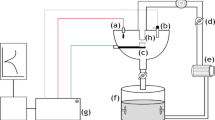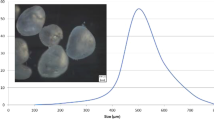Abstract
Synergistic effect between corrosion and wear has been widely recognized in many tribo-corrosion systems. In most wet application conditions, dissolved oxygen (DO) is a controlling factor to the dynamics of corrosion process and is therefore expected to have significant impact on the tribo-corrosion performance of materials. In this study, the effect of DO (0–24 ppm) on erosion–corrosion behaviour of En30B low-alloy steel has been investigated using a slurry pot erosion–corrosion test apparatus in a slurry containing 35 wt% silica sand and 3.5% NaCl solution at 30 and 45 °C. The synergistic effect and its contributing components, i.e. erosion-enhanced corrosion and corrosion-enhanced erosion, have been measured/analysed. The total erosion–corrosion loss and synergy of the En30B steel increases with DO in the slurry, initially rapidly at DO levels below ~5 ppm and then less rapidly at the higher DO levels. The synergistic effect is mainly due to corrosion-enhanced erosion with negligible contributions from erosion-enhanced corrosion. Temperature has a significant effect on the total erosion–corrosion loss. Total erosion–corrosion was 34% higher at 45 °C (in still air) than at 30 °C. Mechanisms for the observed phenomena have been discussed based on the concept of corrosion-accelerated micro-crack propagation.









Similar content being viewed by others
References
Neville A, Reza F, Chiovelli S, Revega T (2005) Erosion–corrosion behavior of WC based MMCs in liquid–solid slurries. Wear 259:181–195
Reyes M, Neville A (2001) Mechanisms of erosion–corrosion on a cobalt-base alloy and stainless-steel UNS S17400 in aggressive slurries. J Mater Eng Perform 10:723–730
Zhang T, Luo Y, Li DY (1999) Modification of aluminide coating with yttrium for improved resistance to corrosive erosion. J Mater Eng Perform 8:635–640
Grewal HS, Agrawal A, Singh H (2013) Design and development of high-velocity slurry erosion test rig using CFD. J Mater Eng Perform 22:152–161
Souza VAD, Neville A (2007) Aspects of microstructure on the synergy and overall material loss of thermal spray coatings in erosion–corrosion environments. Wear 263:339–348
Hussain EAM, Robinson MJ (2007) Erosion–corrosion of 2205 duplex stainless steel in flowing seawater containing sand particles. Corros Sci 49:1737–1744
Barik RC, Wharton JA, Wood RJK, Stokes KR (2009) Electro-mechanical interactions during erosion–corrosion. Wear 267:1900–1908
Neville A, Reyes M, Hodgkiess T, Gledhill A (2000) Mechanisms of wear on a Co-base alloy in liquid–solid slurries. Wear 238:138–150
Neville A, Hodgkiess T (1999) Characterisation of high-grade alloy behaviour in severe erosion–corrosion conditions. Wear 233–235:596–607
Neville A, Hodgkiess T, Xu H (1999) An electrochemical and microstructural assessment of erosion–corrosion of cast-iron. Wear 233–235:523–534
Clark HM (1993) The influence of flow field in slurry erosion. Wear 152:223–240
Tian BR, Cheng YF (2006) Erosion–corrosion of hydrotransport pipes in oil sand slurries. Bull Electrochem 22:329–335
Yu B, Li DY, Grondin A (2013) Effects of the dissolved oxygen and slurry velocity on erosion–corrosion of carbon steel in aqueous slurries with carbon dioxide and silica sand. Wear 302:1609–1614
Postlethwaite J, Dobbin MH, Bergevin K (1986) The role of oxygen mass transfer in the erosion–corrosion of slurry pipelines. Corrosion 42:514–521
Postlethwaite J, Lotz U (1988) Mass transfer at erosion–corrosion roughened surfaces. Can J Chem Eng 66:75–78
Parent LL, Li DY (2013) Wear of hydrotransport lines in Athabasca oil sands. Wear 301:477–482
Yang Y, Cheng YF (2012) Parametric effects on the erosion–corrosion rate and mechanism of carbon steel pipes in oil sands slurry. Wear 276–277:141–148
Rajahram SS, Harvey TJ, Wood RJK (2009) Erosion–corrosion resistance of engineering materials in various test conditions. Wear 267:244–254
Burstein GT, Sasaki K (2000) Effect of impact angle on slurry erosion–corrosion of 304 L stainless steel. Wear 240:80–94
Jana BD, Stack MM (2005) Modelling impact angle effects on erosion–corrosion of pure metals: construction of materials performance maps. Wear 259:243–255
Abbade NP, Crnkovic SJ (2000) Sand–water slurry erosion of API 5L X65 pipe steel as quenched from intercritical temperature. Tribol Int 33:811–816
Meng H, Hu X, Neville A (2007) A systematic erosion–corrosion study of two stainless steels in marine conditions via experimental design. Wear 263:355–362
Mischler S, Debaud S, Landolt D (1998) Wear-accelerated corrosion of passive metals in tribocorrosion systems. J Electrochem Soc 145:750–758
Jemmely P, Mischler S, Landolt D (2000) Electrochemical modeling of passivation phenomena in tribocorrosion. Wear 237:63–76
Jiang J, Stack MM (2006) Modelling sliding wear: from dry to wet environments. Wear 261:954–965
García I, Drees D, Celis JP (2001) Corrosion-wear of passivating materials in sliding contacts based on a concept of active wear track area. Wear 249:452–460
Landolt D, Mischler S, Stemp M, Barril S (2004) Third body effects and material fluxes in tribocorrosion systems involving a sliding contact. Wear 256:517–524
Jiang J, Stack MM, Neville A (2002) Modelling the tribo-corrosion interaction in aqueous sliding conditions. Tribol Int 35:669–679
Guo HX, Lu BT, Luo JL (2005) Interaction of mechanical and electrochemical factors in erosion–corrosion of carbon steel. Electrochim Acta 51:315–323
Xu J, Zhuo C, Tao J, Jiang S, Liu L (2009) Improving the corrosion wear resistance of AISI 316L stainless steels by particulate reinforced Ni matrix composite alloying layer. J Phys D Appl Phys 42:1–12
Rajahram SS, Harvey TJ, Wood RJK (2011) Electrochemical investigation of erosion–corrosion using a slurry pot erosion tester. Tribol Int 44:232–240
Clark HM, Hartwich RB (2001) A re-examination of the ‘particle size’ effect in slurry erosion. Wear 248:147–161
Harvey TJ, Wharton JA, Wood RJK (2007) Development of a synergy model for erosion–corrosion of carbon steel in a slurry pot. Tribol Mater Surf Interfaces 1:33–47
Postlethwaite J, Holdner DN (1975) Wall mass transfer in horizontal slurry pipelines. Can J Chem Eng 53:31–35
Postlethwaite J, Holdner DN (1976) Wall mass transfer in vertical and horizontal slurry pipelines. Can J Chem Eng 54:255–258
Oltra R, Chapey B, Renaud L (1995) Abrasion–corrosion studies of passive stainless steels in acidic media: combination of acoustic emission and electrochemical techniques. Wear 186–187:533–541
Li W, Li DY (2005) Variations of work function and corrosion behaviour of deformed copper surfaces. Appl Surf Sci 240:388–395
Matsumura M, Oka Y, Hiura H, Yano M (1991) The role of passivating film in preventing slurry erosion–corrosion of austenitic stainless steel. ISIJ Int 31:168–172
Postlethwaite J, Brady BJ, Hawrylak MW, Tinker EB (1978) Effects of corrosion on the wear patterns in horizontal slurry pipelines. Corrosion 34:245–250
Postlethwaite J (1981) Effect of chromate inhibitor on the mechanical and electrochemical components of erosion–corrosion in aqueous slurries of sand. Corrosion 37:1–5
Jones M, Waag U (2011) The influence of carbide dissolution on the erosion–corrosion properties of cast tungsten carbide/Ni-based PTAW overlays. Wear 271:1314–1324
Bester JA, Ball A (1993) The performance of aluminium alloys and particulate reinforced aluminium metal matrix composites in erosive-corrosive slurry environments. Wear 162–164:57–63
Zheng Yugui, Yao Zhiming, Wei Xiangyun, Ke Wei (1995) The synergistic effect between erosion and corrosion in acidic slurry medium. Wear 186–187:555–561
Gutman EM (1998) Mechanochemistry of materials. Cambridge International Science Publishing, Cambridge
BT Lu, JL Luo, JF Lu (2004) Chemo-mechanical effect in erosion–corrosion process of carbon steel. Corrosion, Paper 04659
Li Y, Burstein T, Hutchings IM (1995) The influence of corrosion on the erosion of aluminium by aqueous silica slurries. Wear 186–187:515–522
Wood RJK, Hutton SP (1990) The synergistic effect of erosion and corrosion: trends in published results. Wear 140:387–394
Jones M, Llewellyn RJ (2009) Erosion–corrosion assessment of materials for use in the resources industry. Wear 267:2003–2009
ASTM G119 - 09 (2009) Standard guide for determining synergism between wear and corrosion. ASTM International, West Conshohocken. doi:10.1520/G0119-09
R Cooke, G Johnson, P Goosen (2000) Laboratory apparatus for evaluating slurry pipeline wear. In: SAIT Seminar, Economics of Wear Materials, 13 Mar 2000
Acknowledgements
The authors would like to acknowledge members of the NRC/Industry Mining Wear Materials Consortium for their support and sponsorship of this work and express their thanks to Baisheng (Peter) Yao at the Mining Wear and Corrosion Lab for his technical assistance in conducting the experimental work.
Author information
Authors and Affiliations
Corresponding author
Ethics declarations
Conflict of interest
On behalf of all authors, the corresponding author states that there is no conflict of interest.
Rights and permissions
About this article
Cite this article
Jiang, J., Xie, Y., Islam, M.A. et al. The Effect of Dissolved Oxygen in Slurry on Erosion–Corrosion of En30B Steel. J Bio Tribo Corros 3, 45 (2017). https://doi.org/10.1007/s40735-017-0105-0
Received:
Revised:
Accepted:
Published:
DOI: https://doi.org/10.1007/s40735-017-0105-0




